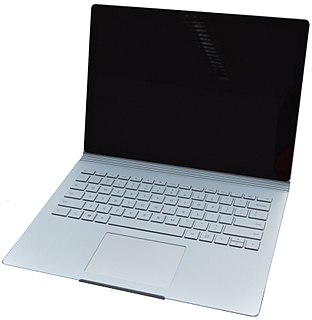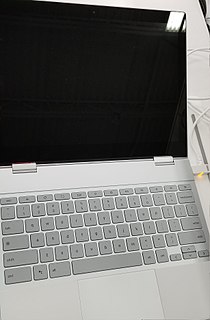
A 2-in-1 PC, also known as convertible laptop, 2-in-1 tablet, 2-in-1 laptop, 2-in-1 detachable, laplet, tabtop, laptop tablet, or simply 2-in-1, is a portable computer that has features of both tablets and laptops.

Lenovo Yoga is a line of consumer-oriented laptop computers and tablets designed, developed and marketed by Lenovo, named for their ability to assume multiple form factors due to a hinged screen.

Microsoft Surface is a series of touchscreen-based personal computers, tablets and interactive whiteboards designed and developed by Microsoft, running the Microsoft Windows operating system, apart from the Surface Duo, which runs on Android. The devices are manufactured by original equipment manufacturers, including Pegatron, and are designed to be premium devices that set examples to Windows OEMs. It comprises seven generations of hybrid tablets, 2-in-1 detachable notebooks, a convertible desktop all-in-one, an interactive whiteboard, and various accessories all with unique form factors. The majority of the Surface lineup features Intel processors and are compatible with Microsoft's Windows 10 or Windows 11 operating system.

The Surface Pro is a first generation 2-in-1 detachable of the Microsoft Surface series, designed and manufactured by Microsoft. The device ran a 64-bit version of Windows 8 Pro operating system with a free upgrade possibility to Windows 8.1 Pro, and eventually also Windows 10. Initially announced as Surface for Windows 8 Pro on June 18, 2012, at a Los Angeles event, Microsoft later renamed the device to Surface Pro, and launched it on February 9, 2013.

The Surface Pro 2 is a Surface-series 2-in-1 detachable produced by Microsoft. Unveiled at an event in New York City on September 23, 2013 and released on October 22, 2013, it succeeds the Surface Pro released in February 2013. While maintaining a design similar to the original design of its predecessor, the Surface Pro 2 has improved hardware specifications compared to it, such as a Haswell Intel Core processor and an increased number of storage options, improved versions of the kickstand and cover accessories.

The Surface Pro 3 is the third-generation Surface-series 2-in-1 detachable, designed, developed, marketed, and produced by Microsoft. It originally ran the Windows 8.1 Pro operating system (OS), but the optional upgrade to Windows 10 Pro (OS) operating system was later added.

Surface 3 is a 2-in-1 detachable from the Microsoft Surface series, introduced by Microsoft in 2015. Unlike its predecessor, the Surface 2, Surface 3 utilizes an x86 Intel Atom system-on-chip architecture, or SoC, rather than a processor with ARM architecture such as the Nvidia Tegra that powered the Surface 2, and runs standard versions of Windows 8.1 or Windows 10.

The Surface Pro 4 is the fourth-generation Surface-series 2-in-1 detachable, designed, developed, marketed, and produced by Microsoft. The Surface Pro 4 was announced on October 6, 2015 alongside the Surface Book. In the U.S. and Canada, the Surface Pro 4 was released on October 26, 2015.

The Surface Book is a 2-in-1 PC designed and produced by Microsoft, part of the company's Surface line of personal computing devices. Surface Book is distinguished from other Surface devices primarily by its full-sized, detachable keyboard, which uses a dynamic fulcrum hinge that expands when it is opened. The keyboard contains a second battery, a number of ports and an optional discrete graphics card used when the screen part, also dubbed as the clipboard by Microsoft, is docked to it. Unlike Surface Pro devices, which are marketed as tablets, the Surface Book is marketed as a laptop, Microsoft's first device marketed as such. Unlike the Surface Laptop devices, the two parts are detachable.

The Surface Laptop is a laptop computer designed by Microsoft as part of the company's Surface line of personal computing devices.

The Pixelbook is a portable laptop/tablet hybrid computer developed by Google which runs Chrome OS. It was announced on October 4, 2017 and was released on October 30.
The Surface Laptop 3 is a laptop computer developed by Microsoft. It is the third generation of Surface Laptop and was unveiled alongside the Surface Pro 7 and Surface Pro X on an event on 2 October 2019. It succeeds the Surface Laptop 2 that was released in October 2018.
The Surface Pro 7 is a 2-in-1 detachable tablet computer developed by Microsoft. It is the seventh generation of Surface Pro and was announced alongside the Surface Laptop 3 and Surface Pro X at an event on 2 October 2019. An updated version of the device was introduced on the 11th of January 2021 called the Surface Pro 7+. Surface Pro 7 and 7+ maintain the same form and design as previous models but with the Mini DisplayPort receptacle replaced by a USB-C port. The display of the device is the same as the previous model with a 2736 x 1824 resolution touchscreen in 3:2 aspect ratio and 267 ppi. The Surface Pro 7 starts at $750 and goes up to $2,300. The Surface Pro 7+ for Business starts at $900 and goes up to $2,800.

The Surface Pro X is a 2-in-1 detachable tablet computer developed by Microsoft. It was developed alongside and was announced on 2 October 2019 alongside the Surface Pro 7 and Surface Laptop 3. Updated hardware was announced alongside Surface Laptop Go and Surface accessories on October 1, 2020 and September 22, 2021. The device starts at $899.99 USD / £849.99.
The Surface Book 3 is the third generation of Microsoft's Surface Book series, and a successor to the Surface Book 2. Like its previous generation, the Surface Book 3 is part of the Microsoft Surface lineup of personal computers. It is a 2-in-1 PC that can be used like a conventional laptop, or detached from its base for use as a separate tablet, with touch and stylus input support in both scenarios. It was announced by Microsoft online alongside the Surface Go 2 on May 6, 2020, and later released for purchase on May 12, 2020.
The Surface Go 2 is a 2-in-1 detachable tablet computer developed by Microsoft. It is the second generation of Surface Go and was announced alongside the Surface Book 3 on May 6, 2020 online. It was available for purchase starting May 12, 2020. In October 2021, this has been superseded by the Surface Go 3.
The Microsoft Surface Go 3 is the third generation model of the Surface Go series of devices, introduced as the successor to the Surface Go 2 by Microsoft at their Surface Event on September 22, 2021. It was announced by the company alongside Surface Laptop Studio, Surface Pro 8, Surface Duo 2 and a bunch of Surface accessories. The tablet has the same body, the same set of cameras and speakers, the same ports, and the same dimensions as its predecessor; the main enhancement is a range of more powerful processors. The tablet is powered by the new Windows 11 operating system.
Surface Laptop Studio is a newly introduced product line by Microsoft at their Surface Event on September 22, 2021. It was announced by the company alongside the Surface Go 3 and Surface Pro 8, Surface Duo 2 and a bunch of Surface accessories. The device is a new form factor featuring a dual-pivoting screen that flips into tablet mode. The laptop is powered by the new Windows 11 operating system.
The Surface Laptop SE is a laptop computer manufactured by Microsoft. Unveiled on November 9, 2021, it is an entry-level model in the Surface Laptop series positioned exclusively towards the education market. It is scheduled to be released in early-2022.
















